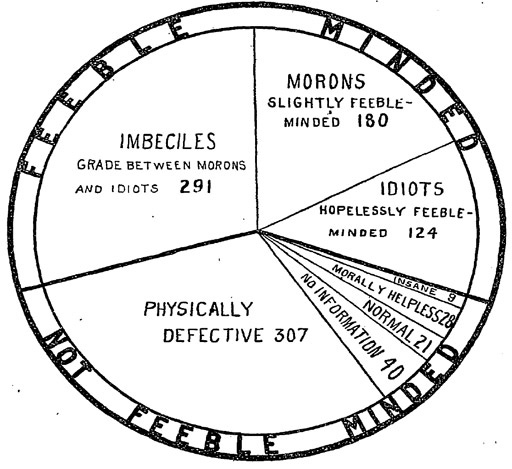Pennhurst - Categorizing the Children |
||
| Definition: The following outlines how Pennhurst categorized their patients, often collectively called "children," however the age of the residents ranged from infants to people over 70 years old. | ||
The patients at Pennhurst were mostly young and were often collectively called "children," however the age of the residents ranged from infants to people over 70 years old. They were generally separated by their IQ level, which was categorized into three main groups: Morons (59-69), Imbeciles (20-49), and Idiots (below 20). These medical terms were antiquated before they became popular in common slang, and were replaced with the terms: Mild, Moderate, Severe, and Profound Mental Retardation. The lowest functioning patients were mostly bed-ridden in cribs, unable to move much or feed themselves. The amount of care needed for the patients here to attempt any kind of rehabilitation was quite a formidable task. Daily physical tasks such as changing diapers, showers, and assistance with walking were needed, as well as educational programs - the overcrowded atmosphere and lack of trained staff made both types of activities take a back seat. As with most mental and developmental institutions run by the states in the U.S., the role of the hospital shifted quickly from treatment as a goal to custodial care. Low wages, long hours, and the overcrowded workplace kept many skilled doctors and nurses from applying for jobs, creating an even more difficult situation. In 1946, there were only seven physicians serving over 2,000 patients at Pennhurst with no room for the 1,000 still on the waiting list for admission; the patient census peaked at 3,500 in 1955. Therapeutic facilities were constructed, but sat disused due to lack of trained staff. The funding problem also put a stranglehold on the maintenance of the buildings, and the daily budget for each patient sunk so low that some basic needs could not be met. The institution was found guilty of violating patient's constitutional rights in a class-action lawsuit, ruled by U.S. District Judge Raymond J. Broderick in 1977. Reports of beatings by staff and other patients, assault, and extended periods of isolation were uncovered, causing residents to regress farther and farther into a mentally disturbed state of mind, instead of being bettered by the school. An ex-patient, Roland Johnson, writes about his experiences at Pennhurst in his autobiography, Lost in a Desert World (1994). Many other documents, including abuse reports, patient case studies, and behavior modification reports can be found at El Peecho's Pennhurst website. |
||
Collections: Eastern Pennsylvania State Institution
|
||
Related Categories: | Interactive Pennhurst Timeline | Pennhurst State School and Hospital | Behind Closed Doors | Excerpts from Halderman vs. Pennhurst State School | Pennhurst - Property Layout | Pennhurst Today | Pennhurst - General Operations | Lost in a Desert World | Pennhurst - Suffer The Little Children | Hauntings at Pennhurst | |
||
Resources:
|
||
| db#836 | ||
What are your thoughts? |
